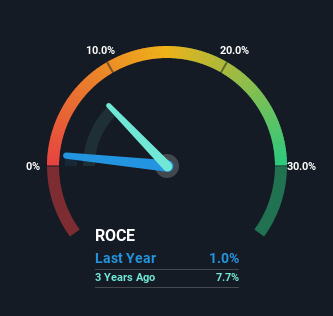- United States
- /
- Specialty Stores
- /
- OTCPK:PRTY.Q
Some Investors May Be Worried About Party City Holdco's (NYSE:PRTY) Returns On Capital

When researching a stock for investment, what can tell us that the company is in decline? When we see a declining return on capital employed (ROCE) in conjunction with a declining base of capital employed, that's often how a mature business shows signs of aging. Ultimately this means that the company is earning less per dollar invested and on top of that, it's shrinking its base of capital employed. So after glancing at the trends within Party City Holdco (NYSE:PRTY), we weren't too hopeful.
What Is Return On Capital Employed (ROCE)?
For those who don't know, ROCE is a measure of a company's yearly pre-tax profit (its return), relative to the capital employed in the business. To calculate this metric for Party City Holdco, this is the formula:
Return on Capital Employed = Earnings Before Interest and Tax (EBIT) ÷ (Total Assets - Current Liabilities)
0.0098 = US$22m ÷ (US$3.1b - US$816m) (Based on the trailing twelve months to June 2022).
Therefore, Party City Holdco has an ROCE of 1.0%. Ultimately, that's a low return and it under-performs the Specialty Retail industry average of 17%.
See our latest analysis for Party City Holdco

In the above chart we have measured Party City Holdco's prior ROCE against its prior performance, but the future is arguably more important. If you're interested, you can view the analysts predictions in our free report on analyst forecasts for the company.
What The Trend Of ROCE Can Tell Us
In terms of Party City Holdco's historical ROCE trend, it isn't fantastic. Unfortunately, returns have declined substantially over the last five years to the 1.0% we see today. What's equally concerning is that the amount of capital deployed in the business has shrunk by 22% over that same period. The fact that both are shrinking is an indication that the business is going through some tough times. Typically businesses that exhibit these characteristics aren't the ones that tend to multiply over the long term, because statistically speaking, they've already gone through the growth phase of their life cycle.
On a side note, Party City Holdco's current liabilities have increased over the last five years to 26% of total assets, effectively distorting the ROCE to some degree. If current liabilities hadn't increased as much as they did, the ROCE could actually be even lower. While the ratio isn't currently too high, it's worth keeping an eye on this because if it gets particularly high, the business could then face some new elements of risk.
The Bottom Line
In summary, it's unfortunate that Party City Holdco is shrinking its capital base and also generating lower returns. This could explain why the stock has sunk a total of 89% in the last five years. Unless there is a shift to a more positive trajectory in these metrics, we would look elsewhere.
If you want to know some of the risks facing Party City Holdco we've found 2 warning signs (1 is potentially serious!) that you should be aware of before investing here.
While Party City Holdco isn't earning the highest return, check out this free list of companies that are earning high returns on equity with solid balance sheets.
New: Manage All Your Stock Portfolios in One Place
We've created the ultimate portfolio companion for stock investors, and it's free.
• Connect an unlimited number of Portfolios and see your total in one currency
• Be alerted to new Warning Signs or Risks via email or mobile
• Track the Fair Value of your stocks
Have feedback on this article? Concerned about the content? Get in touch with us directly. Alternatively, email editorial-team (at) simplywallst.com.
This article by Simply Wall St is general in nature. We provide commentary based on historical data and analyst forecasts only using an unbiased methodology and our articles are not intended to be financial advice. It does not constitute a recommendation to buy or sell any stock, and does not take account of your objectives, or your financial situation. We aim to bring you long-term focused analysis driven by fundamental data. Note that our analysis may not factor in the latest price-sensitive company announcements or qualitative material. Simply Wall St has no position in any stocks mentioned.
About OTCPK:PRTY.Q
Party City Holdco
Party City Holdco Inc. designs, manufactures, sources, and distributes party goods worldwide.
Slightly overvalued with weak fundamentals.
Market Insights
Community Narratives




